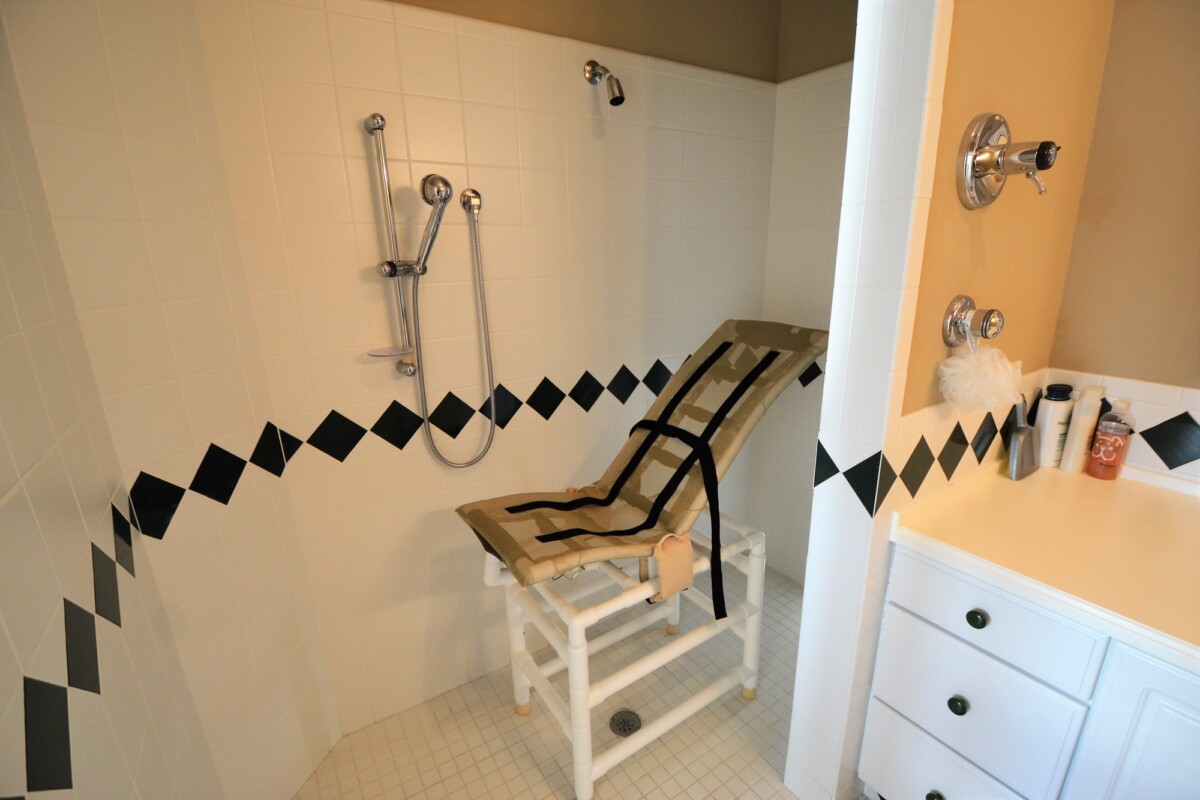Roll-In Showers: The Perfect Blend of Safety and Style
[tta_listen_btn]
As home accessibility becomes a bigger priority in 2025, roll-in showers are emerging as essential bathroom upgrades—especially for seniors and individuals with mobility issues. Designed to eliminate barriers and promote independence, these curbless showers provide an elegant yet functional solution for modern homes. Whether you’re retrofitting your current bathroom or building a new accessible space, understanding the features, costs, and installation process of a roll-in shower will help you make an informed decision.
What Is a Roll-In Shower?
A roll-in shower is a barrier-free showering space that allows individuals—especially those in wheelchairs—to easily roll in and out without needing to step over a threshold or curb. These showers typically have:
-
No lip or edge (curbless entry)
-
Wide entryways
-
Slip-resistant floors
-
Optional seating
-
Wall-mounted grab bars
They are a top choice for universal design and accessibility.
Benefits of Installing a Roll-In Shower
Enhanced Accessibility
The primary benefit of a roll-in shower is unparalleled accessibility. It’s ideal for users with wheelchairs, walkers, or limited mobility, ensuring easy, independent access.
Modern Design Aesthetics
Roll-in showers also offer a sleek, open-concept look, which fits well with modern bathrooms. Frameless glass, tile finishes, and minimalist hardware create a luxurious spa-like vibe.
Improved Safety Features
Incorporating anti-slip tiles, adjustable showerheads, and built-in benches reduces the risk of slips and falls, making roll-in showers a much safer alternative to traditional tubs or enclosed showers.
Roll-In Shower vs. Walk-In Shower
Though often used interchangeably, these two shower types have critical differences:
Key Differences in Design
When comparing roll-in showers and walk-in showers, there are several design elements to consider:
-
Threshold: A roll-in shower has no threshold and is curbless, allowing easy access for wheelchairs. In contrast, a walk-in shower usually has a low threshold.
-
Wheelchair Access: Roll-in showers are designed for full wheelchair access, whereas walk-in showers offer limited accessibility.
-
Drainage: Roll-in showers typically feature center or linear drains to accommodate the curbless design, while walk-in showers usually have a standard center drain.
-
Cost: Roll-in showers tend to be more expensive than walk-in showers due to the customizations required for accessibility and the curbless design.
Roll-in showers win when it comes to full ADA compliance and wheelchair access. Walk-in showers are still suitable for mobile individuals who prefer a low-entry design.
Ideal User Considerations
-
Roll-In: Best for wheelchair users or those requiring caregiver assistance.
-
Walk-In: Best for older adults who remain semi-mobile but want safety.
Who Needs a Roll-In Shower?
Seniors and Aging in Place
With aging-in-place becoming more common, roll-in showers are an essential upgrade in ensuring home safety and independence.
People with Disabilities
From spinal injuries to degenerative diseases like MS or Parkinson’s, roll-in showers provide the dignity of independent bathing.
Veterans and Injured Individuals
Veterans and those recovering from surgery or injury benefit significantly from barrier-free, therapeutic showers.
Types of Roll-In Showers
Curbless Showers
These showers are fully integrated into the bathroom floor, offering a seamless transition from bathroom to shower.
Portable Roll-In Units
Great for temporary setups or rentals, these units offer mobility-friendly features with easier installation.
Barrier-Free Models
Often used in hospitals and rehab centers, these come with features like built-in benches, hand-held showers, and grab bars.
How to Choose the Best Roll-In Shower in 2025
Size and Layout Requirements
The standard size for ADA compliance is 36” x 36” or larger. Ensure that your bathroom can accommodate the layout.
Safety Add-ons: Grab Bars, Seats, and Non-Slip Flooring
To fully optimize your shower for safety:
-
Install ADA-approved grab bars
-
Add a folding seat or built-in bench
-
Use non-slip mosaic tiles
Drainage and Plumbing Considerations
A linear drain is often used to facilitate proper drainage and avoid pooling. Ensure your plumbing system is updated to handle the shower’s capacity.
Roll-In Shower Installation Process
Step-by-Step Installation Overview
-
Demolish existing shower/tub
-
Prepare subfloor and plumbing
-
Install shower pan and drain
-
Tile the floor and walls
-
Add safety and accessibility features
-
Finish with glass enclosure (optional)
DIY vs. Professional Installation
While a skilled DIYer may attempt this, a professional installer is recommended, especially for correct drainage slope and waterproofing.
Roll-In Shower Costs in 2025
The cost of installing a roll-in shower in 2025 varies based on the material, design, and complexity of the installation:
-
Basic Roll-In Kit: Expect to pay between $1,500 and $3,000 for a standard kit.
-
Mid-Range Custom Design: Custom features and design upgrades will generally range from $4,000 to $7,000.
-
Luxury Curbless Install: For high-end, curbless designs, costs can go from $8,000 to $12,000+.
These prices may vary depending on the contractor, location, and specific customizations you choose.
Labor Costs
Installation labor ranges from $1,000 to $3,500, depending on structural changes, tile work, and local labor rates.
Extra Features and Customizations
-
Grab bars: $100 – $300
-
Built-in seating: $200 – $500
-
Anti-slip flooring: $300 – $600
Does Medicare Cover Roll-In Showers in 2025?
Eligibility Requirements
Medicare does not typically cover home modifications, including roll-in showers unless deemed medically necessary and prescribed by a doctor.
Medicare vs Medicaid vs VA Coverage
-
Medicare: This may cover durable medical equipment, not renovations.
-
Medicaid: Some state programs offer home modification waivers.
-
VA: Veterans may qualify for HISA grants of up to $6,800 for bathroom modifications.
Roll-In Shower Maintenance Tips
Weekly Cleaning Routine
Use mild soap and non-abrasive scrubbers to maintain the tiles and fixtures. Clean drain covers regularly.
Long-Term Durability Care
Seal grout every 6–12 months and check for signs of mold or leakage. Maintain silicone edges and caulking.
Real User Testimonials and Case Studies
Case Study: Mrs. Lillian, Age 78: “I had a roll-in shower installed after my fall last year. It’s made my life so much easier. I can shower without help now!”
Veteran Story: Sgt. Daniel: “The VA helped cover the cost of my accessible shower after my injury. The roll-in model has helped me regain independence.”
Top Brands Offering Roll-In Showers in 2025
-
Safe Step
-
American Standard
-
Ella’s Bubbles
-
Best Bath Systems
-
Kohler Walk-In and Roll-In Solutions
FAQs
What does a roll-in shower mean?
A roll-in shower is a curbless shower designed for wheelchair users, allowing them to enter without stepping over a threshold.
Will Medicare pay for a roll-in shower?
Typically, no, but in medically necessary cases, partial aid through Medicare Advantage or state programs may apply.
What’s the difference between a walk-in shower and a roll-in shower?
A walk-in shower has a low threshold; a roll-in shower has no threshold, making it fully wheelchair accessible.
How much does it cost to put in a roll-in shower?
On average, it costs $4,000 to $12,000, depending on customization and installation needs.
Is a roll-in shower ADA-compliant?
Yes, when built to specific size and feature standards, including grab bars, bench, and accessible controls.
Can I install a roll-in shower in a small bathroom?
Yes, but it may require structural modifications and expert planning to optimize the space.
Final Thoughts
In 2025, a roll-in shower is more than just a convenience—it’s a lifesaving, dignity-enhancing, future-proof investment in your home. Whether for seniors aging at home, individuals with disabilities, or families planning ahead, these showers offer comfort, safety, and peace of mind.
From understanding the differences between walk-in and roll-in options to navigating costs and Medicare coverage, this guide has covered everything you need to make the best decision. Consult with a certified installer, explore available financial aid, and elevate your quality of life—one safe shower at a time.
Save time and money—compare Medicare plans for free at NewMedicare.com or call 📞 (833) 203-6742!






